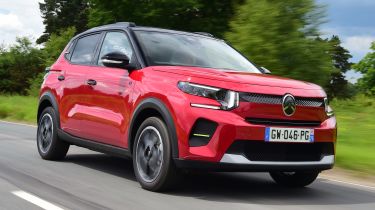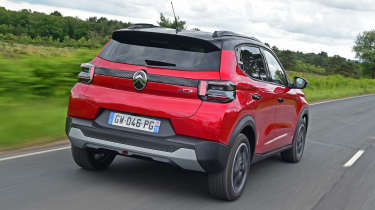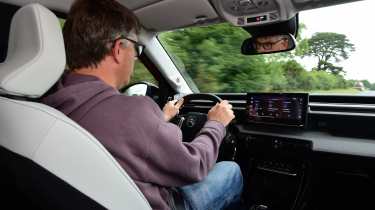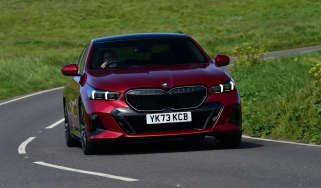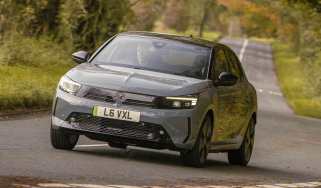New Citroen e-C3 2024 review: French supermini is an electric sensation
The new all-electric Citroen e-C3 supermini offers the perfect blend of space, ride comfort and low running costs

Verdict
There’s a distinct feeling of ‘perfect car at the perfect time’ for the Citroen e-C3. It’s the first usable, small electric car that’s the same price as petrol-powered alternatives without presenting any obvious compromises. Indeed, the C3’s impressive space and ride comfort, plus the promise of tiny running costs from the electric powertrain, give small car buyers a long list of very compelling reasons to buy it over any other alternative.
It seems like every week a new electric SUV turns up on the market. And while we can only commend most of those cars for their smoothness, refinement and by the fact that they’re still more energy efficient than a petrol or diesel car of an equivalent size, we can’t help but think that very few of them actually show electric cars in their best light.
If a transition to a fully electric future is going to happen sooner rather than later, there must be more options that don't make you wince at their size when squeezing into a multi-storey car park as much as they do when clocking your bank statement after buying one. What we desperately need is more small electric cars and more affordable electric cars.
More reviews
Car group tests
- Dacia Sandero vs Citroen C3: 2023 twin test review
- Citroen C3 vs Suzuki Swift: 2021 group test review
- Hyundai i20 vs Citroen C3 vs Nissan Micra
In-depth reviews
- Citroen C3 Origin review
- New Citroen e-C3 2024 review: French supermini is an electric sensation
- Citroen C3 review
Road tests
Used car tests
And while discounts on many existing EVs have made things more attainable in recent months, it’s not until now, and the all new Citroen e-C3, where a vehicle has arrived that really changes everything. That’s because you can get behind the wheel of this new, all-electric supermini for a few pounds under 22 grand. That’s less than you’ll pay for a mid-spec Volkswagen Polo with a petrol engine.
To achieve this, Citroen hasn’t gone for headline-grabbing electric specs or hot hatch-busting acceleration times; it has merely aimed for the sort of performance that you’d expect from a regular internal combustion-powered small car. That means that the single electric motor up front sends 111bhp and 120Nm of torque to the front wheels.
The battery is generally the most expensive part of an electric powertrain, so Citroen has an answer here, too. The e-C3’s internal chemistry is based on a lithium iron phosphate (LFP) pack; this uses fewer rare earth metals than the traditional batteries of many electric cars, which means that it’s also a little cheaper to produce. At 44kWh, the capacity is fairly modest, too, so despite those boxy proportions, the e-C3 is actually a little lighter than the likes of a Vauxhall Corsa Electric.
Officially, range is 198 miles, and our drives, both on the international launch in Austria and here in the UK, have yielded efficiency figures of around 4.0 miles per kWh, which translates into a real-world capability of around 175 miles. While some will think that’s a little low, many will have to ask themselves just how often they will cover 175 miles in a day anyway.
If the answer is more than ‘occasionally’, the good news is the mix of that modestly sized battery pack and 100kW charging means a 20-80 per cent top up will take a reasonable 26 minutes. Charge at home with an electricity provider that offers competitive off peak rates – some as low as 7.5p/kWh overnight – and that efficiency rating translates into fuel costs of £188 over 10,000 miles. Over the same distance, a Skoda Fabia 1.0 TSI, which achieved an excellent 60.1mpg in a recent Auto Express Real World road test, would cost £1,105 to fuel, assuming a petrol cost of £1.46 per litre.
If you are charging at home, then a standard 7.4kW onboard charger allows for a 20-80 per cent top up in four hours and 10 minutes; an optional 11kW charger boosts that to two hours and 50 minutes. One concession to that cheap price, however, is that there’s no option of a heat pump. While we’ve yet to test the e-C3 in cold conditions, that means that the range might take a bit of a hit in winter.
Purely as a numbers game, though, the e-C3 is looking incredibly tempting. But there’s a huge amount of appeal elsewhere that only adds to that powertrain.
At just over four metres long, the C3 is a typical supermini length, but at nearly 1.6 metres tall, its roofline is up there with those of small SUVs. This boxy shape has allowed Citroen to maximise cabin space within its modest footprint, to the point where rear cabin space is seriously impressive. While other Stellantis small cars like the Corsa and the Jeep Avenger feel a little tight in the back, the C3 gives occupants loads of space to stretch out. Even if it were competing in the class above, it would be setting a pretty high standard for space. Granted, the flip side of that is a 310-litre boot that’s merely okay instead of stellar, but it’s still not what we’d call pokey.
Up front, there are some hard plastics that give away the low price point, but the use of fabric trims on the dash, contrasting colours and textured materials means it doesn’t feel nasty. We think the little labels on the doors with positive messages like ‘be cool’ and ‘have fun’ are more than a little bit cringey, though.
At least the overall layout is logical, and the 10.25-inch touchscreen, though not the brightest, gets the job done adequately. The small steering wheel doesn’t block the slim digital instrument panel above as we often find in the case with some Peugeots. Better still, that chunky bonnet makes the front of the car very easy to position when parking.
Onto the drive, then, and the e-C3 feels like you hope a Citroen would. Rather than chasing sporty handling, the focus here is on comfort. It uses the “Advanced Comfort” hydraulic bump stops we’ve seen on several of the brand’s larger models already. Along with memory foam-padded seats, it makes for a very relaxing companion over most roads, soaking up bumps that would jostle many other slow cars.
Downsides? Well the handling is just fine rather than fun, the steering offers little to no feedback, and a mix of low-speed motor whine and wind noise above 40mph or so take a slight shine off the refinement. But none of these is exactly a deal breaker.
Those used to the peppiness of EVs will feel a little short changed here, because the 0-62mph time takes 11 seconds. In reality, a lot of new EVs have somewhat skewed what seems like a necessary level of performance, with many matching figures that would’ve seemed great for a hot hatch only 10 years ago. The e-C3, on the other hand, merely matches petrol or diesel superminis that are available for similar cash. The only difference is that electric motor makes it more responsive at any speed than those cars, and the smoothness of the powertrain makes it much easier to drive.
The headline £21,990 starting price gets you the Plus trim, which gets Android Auto and Apple CarPlay, plus lane-departure warning, speed-limit recognition and cruise control. The top spec Max asks £1,700 more for the likes of a reversing camera, LED tail-lights, and a heated steering wheel, heated windscreen, and heated front seats.
If it still somehow sounds a bit pricey, then fear not; Citroen plans to bring an even cheaper e-C3 to the UK next year. The range will become more limited, because it’ll come with a smaller battery that returns a WLTP range of 124 miles, but the benefit of that is that we expect it to cost somewhere in the region of £19,000.
| Model: | Citroen e-C3 Max |
| Price: | £23,690 |
| Price from: | £21,990 |
| Powertrain: | 1x e-motor, 44kWh battery |
| Power/torque: | 111bhp/120Nm |
| Transmission: | Single-speed, front-wheel drive |
| 0-62mph: | 11 seconds |
| Top speed: | 84mph |
| Range: | 198 miles |
| Charging: | 100kW (20-80% in 26 mins) |
| Size (L/W/H): | 4,015/1,755/1,577mm |
| On sale: | July |

